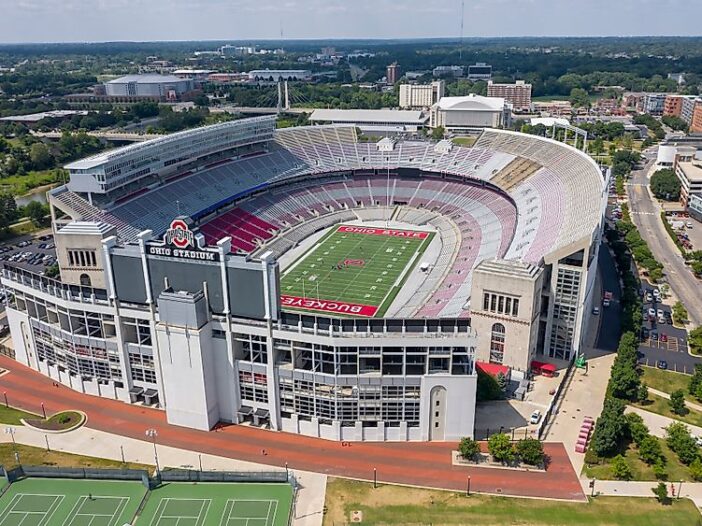
College football stadiums are monumental testaments to the sport’s cultural dominance, with the largest venues dwarfing many professional arenas worldwide. Michigan Stadium, dubbed “The Big House,” leads the pack with a capacity of 107,601, making it the biggest in the U.S. and third globally (NCAA, 2023).
Eight of the world’s ten largest college football stadiums are in U.S, including Penn State’s Beaver Stadium at 106,572 and Ohio State’s Ohio Stadium at 102,780 (Statista, 2023). In 2022, these giants averaged 68,856 fans per game, outpacing NFL attendance by 2% (ESPN, 2023). The University of Michigan reports a record 115,109 attendees for a 2013 game (UMich, 2024), showcasing their massive draw.
Globally, only India’s Narendra Modi Stadium (132,000) and North Korea’s Rungrado Stadium (114,000) surpass them (World Atlas, 2023). This article explores the largest college football stadiums, grounded in data-driven insights.
Biggest and Largest College Football Stadiums Capacity
- Michigan Stadium- 102,733
- Beaver Stadium- 102,455
- Ohio Stadium- 102,321
- Kyle Field- 101,821
- Neyland Stadium- 95,594
- Tiger Stadium- 92,746
- Bryant-Denny Stadium- 91,136
- Darrell K Royal-Texas Memorial Stadium- 88,548
- Sanford Stadium- 87,451
- Rose Bowl- 86,112
- Ben Hill Griffin Stadium- 85,458
- Jordan-Hare Stadium- 81,500
- Gaylord Family Oklahoma Memorial Stadium- 80,795
- Memorial Stadium- 85,458
- Clemson Memorial Stadium- 81,500
- Notre Dame Stadium- 80,321
- Camp Randall Stadium- 80,250
- Williams-Brice Stadium- 79,560
- Doak Campbell Stadium- 77,500
- Los Angeles Memorial Coliseum- 80,795
#1. Michigan Stadium (Ann Arbor, Mich.)

Capacity: 107,601
Michigan Stadium is the largest college football stadiums with a capacity of 107,601. It is popularly called the “Big House”. The stadium is owned by the University of Michigan and has attracted more than 100,000 spectators. The Michigan Stadium is designed with footings to increase the stadium’s capacity to more than 100,000.
On June 21, 2007, the University Board of Regents approved a $226 million renovation and expansion project for Michigan Stadium. Nonetheless, The size of Michigan Stadium is completely unknown from the outside, as most of the seating is in the basement.
#2. Beaver Stadium (University Park, Pa.)

Capacity: 106,572
Beaver Stadium is the second-largest college football stadium. It is located on the campus of Pennsylvania State University, and it’s been home to the Penn State Nittany Lions since 1960, although some parts of the stadium date back to 1909. Notably, In 2016, Beaver Stadium was chosen as the most outstanding football stadium for college football. Because it received over 41% of the vote in an American questionnaire. In 2002, Penn State defined the NCAA record for most fans to see the football team in a season at home.
#3. Ohio Stadium (Columbus, Ohio)

Capacity: 102,780
Ohio Stadium is owned by the Ohio state university. It opened in 1922 as an alternative to Ohio Field and had a capacity of 66,210 seats. The number of seats gradually increased year by year, reaching a total of 91,470 spectators in 1991. However, In 2014, seats were added to the end zone, bringing the official capacity to 104,944.
Another refurbishment was launched in 2017 to add more luxurious suites. Eventually, it led to a decrease of more than 2,000 seats. Mel Kiper Jr. ranked Ohio Stadium second in 2002 after Army and Navy games.
#4. Kyle Field (College Station, Texas)

Capacity: 102,733
Kyle Field is home to Texas A&M Aggies since 1904 as it is owned and located at Texas A&M University. On 1 May 2013, Texas A&M Regents Management approved Kyle’s USD 485 million reconstruction. Restructuring temporarily increases the capacity of official seats up to 106,511 people for the 2014 season, which makes it the largest Texas stadium and the SEC (surpassing Neyland with 57 seats ) and the third-largest football stadium in the country.
Nonetheless, the Stadium’s subsequent restructuring brought the official capacity to 102733 making it one of the biggest college football stadiums in the world, today. The Kyle stadium is considered one of the most intimidating stadiums among the nation’s college football stadiums by various media.
#5. Neyland Stadium (Knoxville, Tenn.)
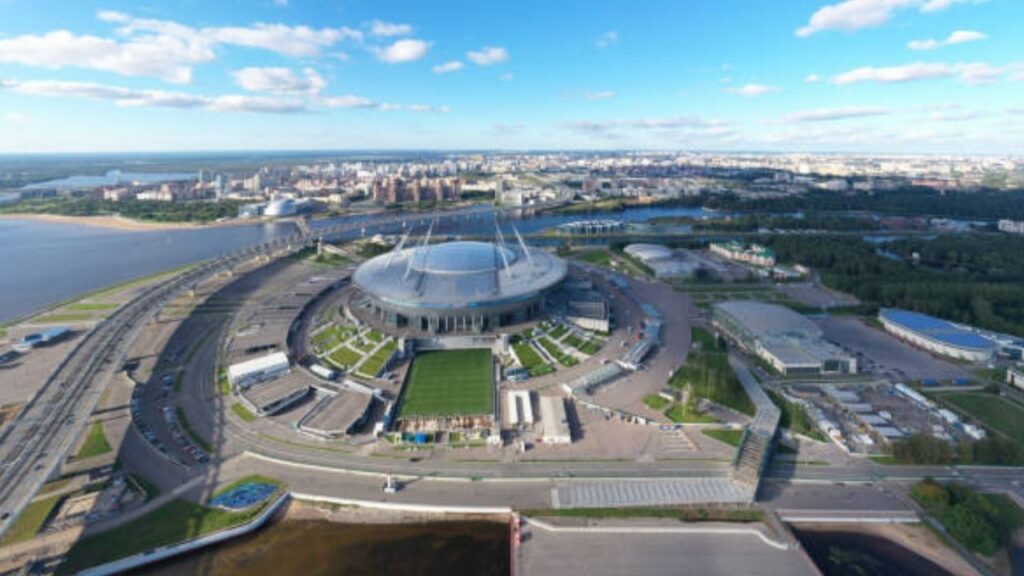
Capacity: 102,455
The Neyland Stadium is listed also as one of the biggest college football stadiums, built in 1921 as Shields-Watkins. It is owned and operated by the University of Tennessee. Of all college football stadiums, it has undergone 16 projects that extend its capacity to 104,079 before being slightly reduced by changes over the next decade.
The stadium took its name from Robert Neyland, which served three stints as a football coach at the University of Tennessee from 1926-1952. However, The latest additions and structure updates were part of a series of restructuring of 136.4 million USD, starting in 2004 and ending in 2010.
#6. Tiger Stadium (Baton Rouge, La.)
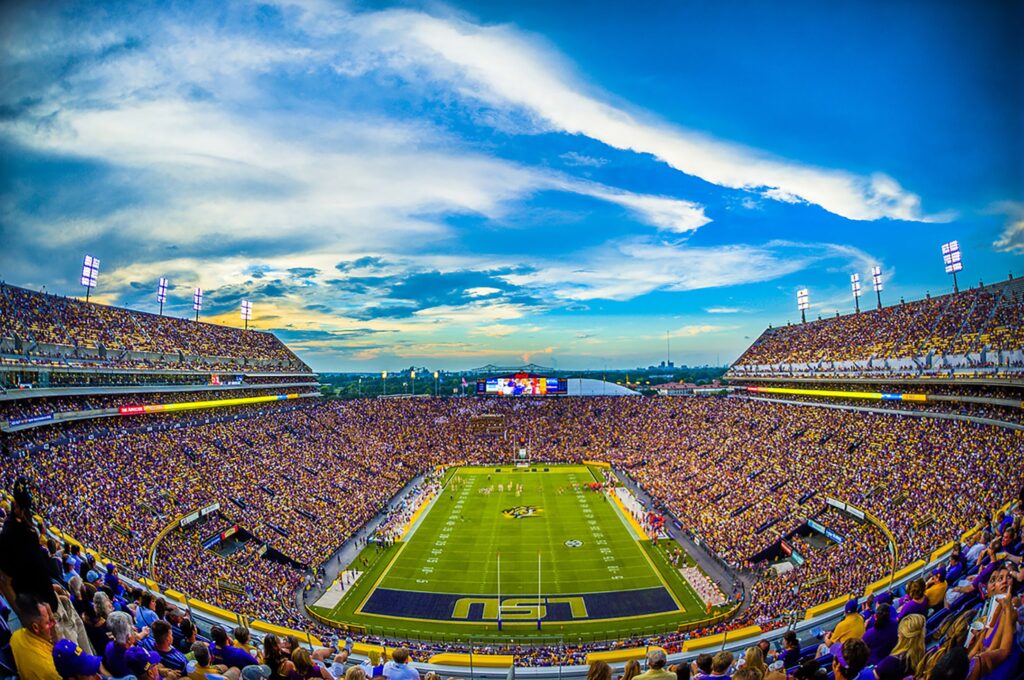
Capacity: 102,321
Tiger Stadium is located on the campus of Louisiana State University. It opened in 1924 with a capacity of 12,000 people. On April 27, 2012, the LSU Supervisory Board voted in favor of the $80 million South End Area Upper Deck expansion with 70 Thai Garden suites, over 3,000 club seats, and over 1,500 suites.
This is to support General public seating making a total capacity of 102,321 at Tiger Stadium. Recently, in 2007, ESPN named Tiger Stadium “the scariest place to play”, and “Tiger Stadium is by far the loudest college football stadium of any stadiums in the country.”
#7. Bryant-Denny Stadium (Tuscaloosa, Ala.)
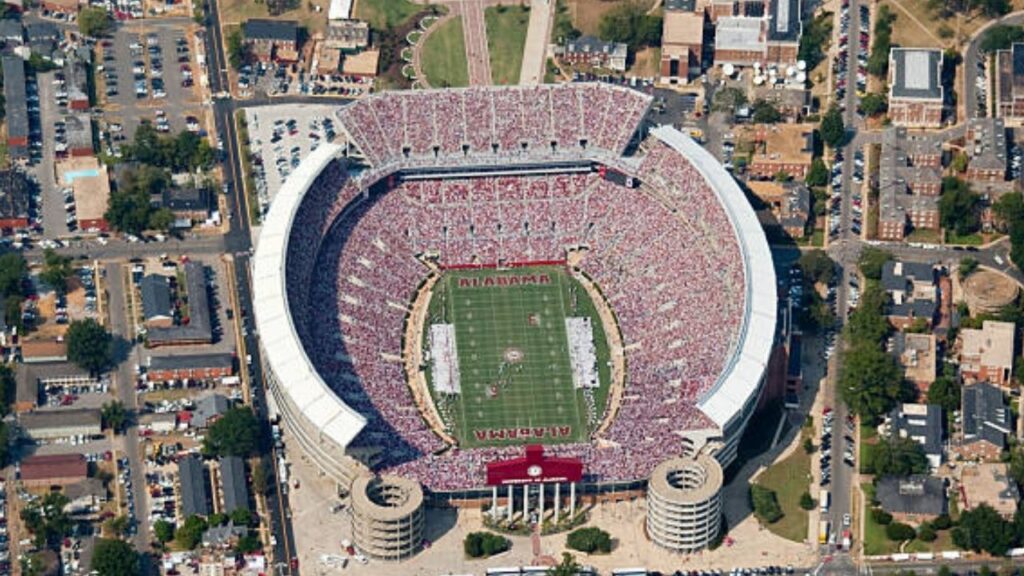
Capacity: 101,821
Bryant Denny Stadium Opened in 1929. The stadium is located on the campus of the University of Alabama in Tuscaloosa. It was named in honor of George H. Denny, who was the president of the school from 1912 to 1932. However, In 1975, the state legislator added a long-lasting head coach and alumni Paul “Bear” Bryant. Before the season from 1937, fixed seats were built along with the oriental reality, growing capacity of 24,000. During the construction of a Viola tide, they played all hours at home since 1987 in the Legion camp in Birmingham, 57 km northeast of Bryant-Sea.
It is part of a larger 600 million-dollar plan to improve sports facilities in the campus sector for $ 92.5 million in the stadium, including new social spaces, circulation improvement, excellent places, and improved spaces for athletes and recruits. Furthermore, The project was funded by USD 48.4 million in bonds and $35 million from the Crimson Tide Foundation, Fundraising Arm of Au Athletics. The construction started shortly after the 2019 season.
#8. Darrell K Royal-Texas Memorial Stadium (Austin, Texas)
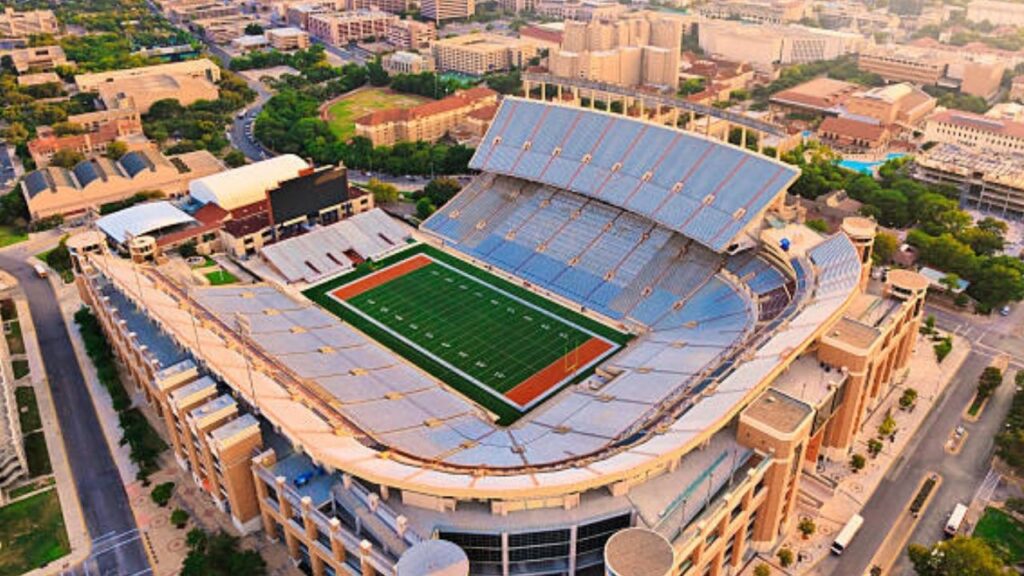
Capacity: 95,594
DKR, located on the campus of the University of Texas, it had the Longhorns football team since 1924. The University of Texas honored the legendary football coach Darrell K Royal. Darrell signed up to the body of the United States Army in 1943, played at the University of Oklahoma under the legendary bud Wilkinson, and lead Texas to three national championships and eleven titles. Thus, South-West Conference officially named the stadium after him in 1996.
In 2006, the Evaluation panel installed a 7,370-square-foot HD Daktronics LED scoreboard, nicknamed “Godzillatron,” located in the south end zone. The Scoreboard was a masterpiece worth $8 million. It is used for audio/visual improvements.
#9. Sanford Stadium (Athens, Ga.)

Capacity: 92,746
The Sanford Stadium is located at the University of Georgia in Athens, Georgia, United States. The game played in Sanford College football stadium is said to be played “in between the hedge” because the field is surrounded by hedges. The hedges are part of the stadium design since its opening in 1929. The hedges were planted in 1996 after the originals were withdrawn to host the 1996 Summer Olympics soccer tournament.
The stadium is named after Dr. Steadman Vincent Sanford, one of the first major forces behind UGA athletics. In 1911, the college football stadium was moved from its location, Herty Field, to a new location named Sanfordfield in his honor. However, On February 14, 2017, the UGA Athletic Board approved a $63 million expansion to renovate the west side of the stadium.
#10. Rose Bowl (Pasadena, Calif.)

Capacity: 91,136
Rose Bowl Stadium is UCLA’s football ground since 1982. The stadium is located and owned by the City of Pasadena. The UCLA Bruins have played home at the Los Angeles Memorial Coliseum since 1928. Though, There was an attempt to build a 44,000-seat stadium on campus where the Truck Complex’s Drake Stadium was built.
However, this proposal was thwarted by influential locals and politicians. In the first rival stadium match between UCLA and USC in 1982, USC fans sat on the west side of the stadium, and UCLA fans sat on the east side of the stadium. This reflects the arrangements when the team shared the Colosseum.
#11. Ben Hill Griffin Stadium (Gainesville, Fla.)

Capacity: 88,548
Popularly known as “The swamp”. The stadium is owned by and located on the campus of the University of Florida. It has a 22,000 capacity when it opened in 1930 but was extended and renewed several times over the ensuing decades.
The name of the Stadium was simply “Florida Field” from its opening in 1930 to 1989. That was when the University renamed the stadium in honor of Citrus magnate Ben Hill Griffin Jr., a graduate and the main beneficiary of the University and its programs. Spurrier formed the appellation of “The Swamp” in 1992.
#12. Jordan-Hare Stadium (Auburn, Ala.)

Capacity: 87,451
The Jordan hare stadium is located at the Auburn University School. Prior to 1939, Auburn had its home games at Drake Field, a bare-bones installation seating only 700 people in provisional bleachers. By the 1980s, Alabama was Auburn’s last prominent rival yet to play a game at Jordan-Hare Stadium.
In 2015, Auburn deemed a complete reconstruction of the north end-zone section of Jordan-Hare. The expenditure of this project was totaled at $145 million. After polling donors and the general fanbase, the university did not go ahead with those plans and determined instead to build a $28 million gameday support facility in the southwest corner of the stadium.
#13. Gaylord Family Oklahoma Memorial Stadium (Norman, Okla.)
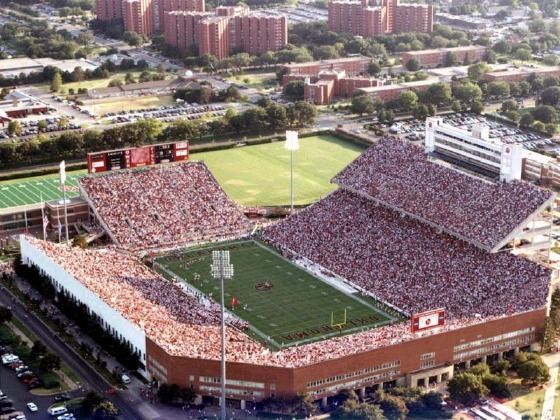
Capacity: 86,112
The Gaylord Family Oklahoma stadium is located on the campus of the University of Oklahoma in Norman. The stadium is a bowl-shaped facility with its major axis facing north-south and enclosed by the north and south ends. Its South End has been closed since the 2015-16 offseason when it was renovated as part of a $160 million project. Originally, the seats consisted of around 500 bleachers on the east side.
The stadium was named Oklahoma Memorial Stadium in honor of college students and staff who died during World War I. The facility was built at a cost of approximately $293,000 and was raised by coach Bennie Owen himself.
#14. Memorial Stadium (Lincoln, Neb.)

Capacity: 85,458
The memorial stadium was built in 1923, located on the campus of the University of Nebraska–Lincoln. It cost 450,000 USD with a capacity of 31080. The first game of the new stadium was a 24-0 Nebraska victory over Oklahoma on October 13, 1923. The extension series led to the current capacity of the stadium since the participation numbers regularly exceed 90,000. At its full capacity, the memorial stadium holds more people than the population of Bellevue.
#15. Clemson Memorial Stadium (Clemson, S.C.)

Capacity: 81,500
The Clemson memorial stadium is located at Clemson in South Carolina and is owned by Clemson University. It has an initial 20,500 capacity when built for $125,000. The Memorial Stadium was opened on September 19, 1942. This was when it defeated Presbyterian University 32-13. The Memorial Stadium’s nickname, Death Valley, comes from both Death Valley National Park in California and the location of the Clemson University Cemetery on a hill. The hill overlooked the site before the upper deck was built.
Perhaps the most famous Clemson football lore is its dramatic entry scene. The tradition of running down the hill began when the football locker room was in the Fike Field House. Today, after leaving the Stadium from the west side, the players are accompanied by police officers to board the bus. They go around the stadium on the east side where the hill is. When the bus arrives from the east side, players exit and gather at the top of the hill, standing around Howards Rock.
#16. Notre Dame Stadium (South Bend, Ind.)

Capacity: 80,795
In place of Cartier Field, the stadium Is located on the campus of the University of Notre dame and opened on October 4, 1930, and defeated SMU. The total construction cost exceeded $750,000 and the initial seating capacity was 54,000. Head coach Knute Rockne played an important role in the design, minimizing the space between the arena and the stand.
The original stadium had 59,075 seats, a circumference of 800 m (0.5 mile), a height of 45 feet (14 m), and a glass-enclosed box 60 feet (18 m) above the ground. The first stand reached 55 rows.
#17. Camp Randall Stadium (Madison, Wisc.)
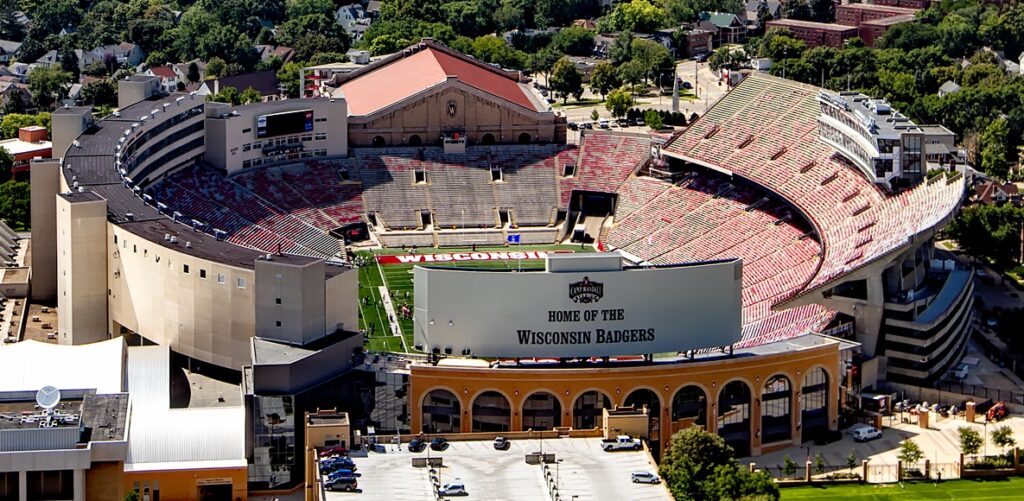
Capacity: 80,321
The stadium is located on the campus of the University of Wisconsin-Madison. It lies on the grounds of Camp Randall, a Union Army training camp during the Civil War. The camp is named after Governor Alexander Randall, who became the United States Postmaster. The stadium also houses the university houses athletic offices.
In 2002, the Reconstruction project was launched. Nevertheless, the project added luxury boxes, a five-story office building, and a separate office for the football program.
#18. Williams-Brice Stadium (Columbia, S.C.)
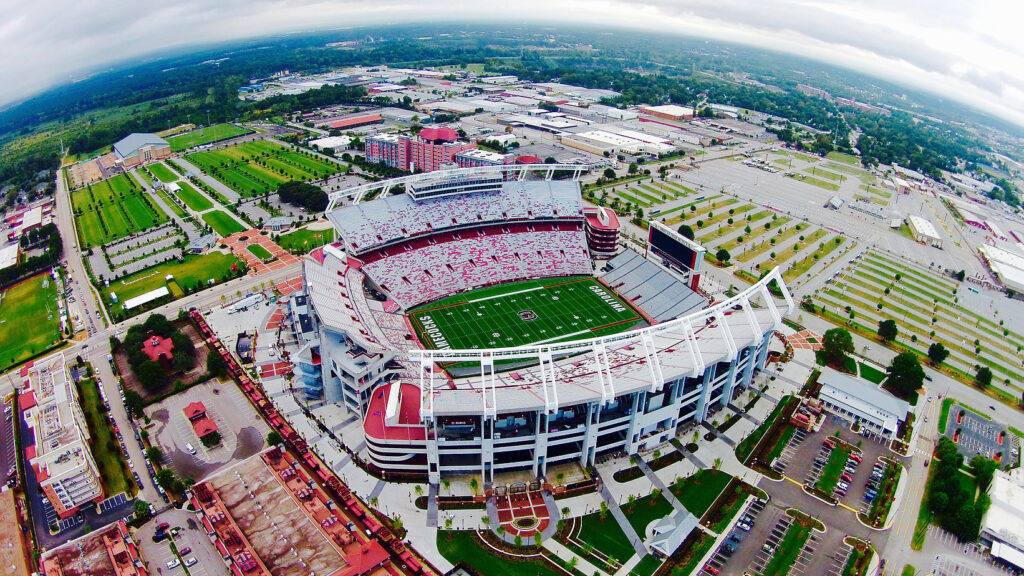
Capacity: 80,250
The stadium is owned and operated by the University of South Carolina. It was originally built in 1934 and was built to replace Melton Field, an aging wooden structure that was located where USC’s Thomas Cooper Library stands today
The stadium is occasionally called “The Cock Pit” by Gamecock fans and local media, and the name has been normally used by these groups since at least the early 1970s. That was when the university held a fund-raising movement to raise money for an AstroTurf playing surface, called “Carpet the Cockpit”.
#19. Doak Campbell Stadium (Tallahassee, Fla.)

Capacity: 79,560
The Doak Campbell Stadium is owned by and located on the campus of Florida state university. It Opened in 1950 and was called Doak Campbell Stadium in honor of Doak S. Campbell, the first president of the university.
The brick facade surrounding the stadium matches the architectural design of most of the buildings on the university campus. On November 20, 2004, the name was changed to Bobby Bowden.
The last stadium to considered in this College football stadium is the Los Angeles Memorial Coliseum.
#20. Los Angeles Memorial Coliseum (Los Angeles)
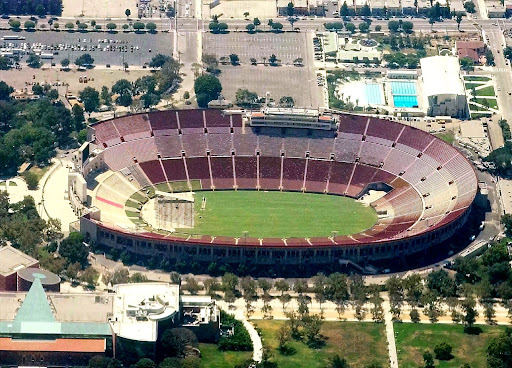
Capacity: 77,500
The Colosseum is owned by the University of Southern California and is located a few miles south of downtown Los Angeles, opposite the USC campus. The stadium is in the heart of a populated area of the city. Though, due to the 1992 Los Angeles riots and the gang problems of the time, the area was reputed to be dangerous in the ’80s and ’90s. However, major events at the Colosseum have dramatically improved security in southern California.
Recent refurbishments have reduced the number of seats and added some modern touches.
List of Best Football Academy in the World
- Barcelona (La Masia)
- Ajax
- Manchester United Academy
- Bayern Munich
- Sporting Lisbon
- Sao Paulo
- Athletic Bilbao
- Southampton
- Schalke 04 (Knappenschmiede)
- Real Madrid (La Fábrica
- River Plate
#1. Barcelona (La Masia)
Located near Camp Nou in the Les Corts district of Barcelona. Undoubtedly the world’s largest football academy, La Masia has produced many stars who have become the face of football in Spain and Europe.
It is a great success for the academy. Lionel Messi, the face of international football in the 21st century and several of the best soccer players in the world, is one of his prominent graduates. Other top players are Andres Iniesta, Xavi, and Puyol, the winners of the 2010 FIFA World Cup.
#2. Ajax
Ajax Football Academy is situated in Amsterdam, Netherlands. The academy has created several well-known talents who have made successful football careers. Here are some of the biggest prospects in European football. The range of the club’s Scouts extends beyond geographical boundaries to all parts of the world where young people enjoy the wonderful sport of football.
Matthijs de Ligt, Frenkie de Jong, Justin Kluivert and Christian Eriksen are among the graduates of this academy.
#3. Manchester United Academy
Manchester United Academy is located at Trafford Training Centre. United Youngsters has a long history of appearing in regular championship games. This has helped their development in global games.
Joint Academy Players were often present in the first team under the direction of the previous coach Sir Alex Ferguson. David Beckham, Danny Welbeck, George Best, Paul Pogba, and Marcus Rashford are ancient from the English Club Academy.
#4. Bayern Munich
Bayern Munich Academy is located in the north of Munich. The academy has achieved its goal of instilling mental and physical strength in players according to the level of the players they produce while maintaining a global presence in football. So far, it’s working well for the team. The majority of the academy players are German and they have been doing great things for their country.
Some of the 2014 German World Cup champions, including Thomas Müller, Philipp Lahm, Bastian Schweinsteiger, and Toni Kroos, started their professional careers at the Bayern Munich Academy.
#5. Sporting Lisbon
The academy is located on the outskirts of Lisbon on the southern bank of River Tejo. One of the obvious achievements of the Sporting Lisbon Football Academy is the production of one of the best players of the 21st century. Cristiano Ronaldo started his career as a member of the Portuguese National Academy.
Except for Ronaldo, they have produced over 100 players who continue to represent their country domestically, while making significant contributions to their respective clubs. Luis Figo, Nani, and Ju Mutinho are graduates.
#6. Sao Paulo
Located at the Morumbi football stadium, The São Paulo Academy offers all the tools you need to create great soccer players, including a well-equipped soccer stadium that meets international standards and a player health program.
They only have the right people to produce high-quality results. Famous Brazilian players Kaka and Oscar Emboaba are graduates of the São Paulo Academy.
#7. Athletic Bilbao
The academy is situated in the town of Lezama. Although many parties address youth development as a way to create or save money. For Athletic Bilbao, it is a question of wealth, tradition, and fierce pride. Shunning the view of the world of its peers, Basque brought almost exclusively on their academy, because they allow only native players of the region to shoot the famous red and white strips.
“Con Cantera y afición, no hace falta importación” they proudly boast “with talent at home and local support, you do not need import.” Iñaki Williams helped to put an end to the long drought trophy, playing an important role in the victory of the Spanish cup of Spanish Athletic over Barcelona at the beginning of the last season and is the last in a long row of very fast stars that appeared to Emerge at San Mame.
#8. Southampton
Southampton FC Academy is located at Southampton FC Training Ground, Long Lane, Marchwood, Southampton. It may not be a difficult opponent in EPL, but it has created its mark in the business of cultivating and teaching youngsters to become world-class players. The club administration has made a price at the club’s ability to identify and recruit youth talent.
30 million investments in new authorized training structures. Its Academy’s high spending showed positive results. This is evident in having elite players of the European Championships as alumni. Gareth Bale, Theo Walcott, and Luke Shaw are examples of such players.
#9. Schalke 04 (Knappenschmiede)
Schalke 04 is in Gelsenkirchen, Germany, and is still a strong competitor in European football. The club regularly participated in the Premier EUROPA Championship, showing the rest of the world that has a quality mine.
The Academy Club has produced several players from the first team that was key contributions to the Victory of Germany in the 2014 FIFA World Cup. For example, Mesut Ozil and Manuel Neuer are the two best goalkeepers in the world.
#10. Real Madrid (La Fábrica)
Real Madrid is one of the most prestigious and successful clubs in Europe. However, one of its academies is situated at Elekahia Port Harcourt; in the same surroundings as the Yakubu Gowon Stadium in Elekahia, Nigeria. The club gains important players to raise the rank of the team while hiding the academy. Unknown to many, the academy has produced some of the best players in Europe.
The club’s farm system produced players such as Alvaro Morata, Carvajal, and Iker Casillas, all of whom played in the main team.
#11. Boca Juniors Reserves and Academy
Boca Juniors is arguably one of the biggest football academies in the world. Located in La boca in Buenos Aires. The club’s academy was productive due to the tradition of looking for young prospects and spending time developing their ability to become world-class players rather than in the transfer market.
Players like Carlos Tevez and Fernando Gago have passed the Boca Juniors Academy.
The last football academy to consider in this Largest College football stadium guide is the River Plate.
#12. River Plate
The River Plate is one of Argentina’s most successful football teams. Schools also regularly participate in South American youth competitions and usually tour the region.
Hernán Crespo and Alfredo Di Stéfano are two well-known footballers who started their careers at the Academy.
Conclusion
In this college football stadiums guide, we discover that United States football always experiences an average turnout of fans, this is partly due to a substantial seating arrangement that caters to hundreds of thousands of supporters.
It is no news that the biggest and loudest college football stadiums are located in the US and other top countries of the world. If you are an athlete or aspiring to become one, you can apply to study in any of the sports academies on our list. There, you can access these world-class sports facilities.
If you don’t want to attend a sports academy, you can enroll in a medical school or become a Flight Attendance. They are all top-paying careers.
Frequently Asked Questions
What is the biggest rivalry in college football?
Top rivalries are Iron Bowl, The Game, Army-Navy, Red River.
What is the largest seating capacity football stadium?
Michigan Stadium is the largest football stadium with 107,601 capacity.
Who is the Number 1 team in college football?
Georgia with 1,550 points
What is the most expensive stadium in the world?
SoFi Stadium and the Total construction cost is $5.5 billion.

Leave a Reply